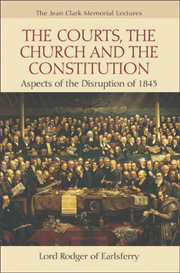Lecture 1 - The Road to the Disruption
Published online by Cambridge University Press: 05 August 2013
Summary
Shortly after half-past two in the afternoon of Thursday, 18 May 1843, in St Andrew's Church in Edinburgh, the Marquis of Bute took his place as Lord High Commissioner to the General Assembly of the Church of Scotland. The retiring Moderator, Dr Welsh, led the assembled ministers and elders in prayer. Then – according to a carefully prepared plan – he begged permission to read out a long protest. He began by declaring that, in consequence of certain proceedings affecting their rights and privileges, which had been sanctioned by the government and legislature, ‘there has been an infringement on the liberties of our constitution, so that we could not now constitute this court without a violation of the terms of the union between Church and State in this land, as now authoritatively declared.’ When he had finished reading, about three-quarters of an hour later, Dr Welsh bowed to the Lord High Commissioner, took his hat and walked out of the church. He was followed by some 200 ministers. Along George Street they went, down Hanover Street and on to the Tanfield Hall in Canonmills, through crowds mostly waving and cheering but just occasionally hissing. When they arrived at the hall at about a quarter to four, many more ministers and elders were waiting to join them. There they set themselves up as the General Assembly of what soon came to be known as the Free Church of Scotland.
- Type
- Chapter
- Information
- The Courts, the Church and the ConstitutionAspects of the Disruption of 1843, pp. 1 - 55Publisher: Edinburgh University PressPrint publication year: 2008

